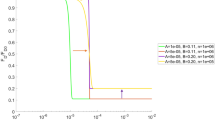Abstract
This paper describes work done to improve and validate the capability of fire dynamics simulator (FDS) to predict the dynamics of water mist sprays. Three single orifice and five multi-orifice spray heads are modeled with FDS based on information on the flow-rate, spray angle, operating pressure and experimentally determined particle size distribution. The capability of FDS to predict the drop size, velocity, mist flux and number concentration profiles within the spray cone is assessed. The effects of turbulence modeling on the predictions of the spray dynamics is investigated. The capability of FDS to predict the air entrainment by high-speed water sprays is validated using experiments in rectangular channels with open ends.










Similar content being viewed by others
References
Deardorff JW (1972) Numerical investigation of neutral and unstable planetary boundary layers. J Atmos Sci. 29:91–115. doi:10.1175/1520-0469(1972)029<0091:NIONAU>2.0.CO;2
Ditch B, Yu HZ (2008) Water mist spray characterization and its proper application for numerical simulations. Fire Saf Sci 9:541–552. doi:10.3801/IAFSS.FSS.9-541
Germano M, Piomelli U, Moin P, Cabot WH (1991) A dynamic subgrid-scale eddy viscosity model. Phys Fluids A 3(7):1760–1765. doi:10.1063/1.857955
Grant G, Brenton J, Drysdale D (2000) Fire suppression by water sprays. Prog Energy Combust Sci 26(2):79–130. doi:10.1016/S0360-1285(99)00012-X
Hart R (2006) Numerical modelling of tunnel fires and water mist suppression. PhD thesis, University of Nottingham. http://etheses.nottingham.ac.uk/185/1/thesis.pdf
Husted B (2007) Experimental measurements of water mist systems and implications for modelling in CFD. PhD thesis, Lund University
Kennedy IM, Moody MH (1998) Particle dispersion in a turbulent round jet. Exp Thermal Fluid Sci 18(1):11–26. doi:10.1016/S0894-1777(98)10009-2
Kim SC, Ryou HS (2003) An experimental and numerical study on fire suppression using a water mist in an enclosure. Exp Thermal Fluid Sci 38(11):1309–1316. doi:10.1016/S0360-1323(03)00134-3
Kim SC, Ryou HS (2004) The effect of water mist on burning rates of pool fire. J Fire Sci 22(4):305–323. doi:10.1177/0734904104041796
McGrattan KB, Hostikka S, Floyd JE, Mell WE, McDermott R (2007) Fire dynamics simulator, technical reference guide, vol 1: Mathematical model. NIST Special Publication 1018, National Institute of Standards and Technology, Gaithersburg
Moin P, Squires K, Cabot W, Lee S (1991) A dynamic subgrid-scale model for compressible turbulence and scalar transport. Phys Fluids A 3(11):2746–2757. doi:10.1063/1.858164
Nmira F, Consalvi J, Kaiss A, Fernandezpello A, Porterie B (2009) A numerical study of water mist mitigation of tunnel fires. Fire Saf J 44(2):198–211. doi:10.1016/j.firesaf.2008.06.002
Prahl L, Holzer A, Arlov D, Revstedt J, Sommerfeld M, Fuchs L (2007) On the interaction between two fixed spherical particles. Int J Multiph Flow 33(7):707–725. doi:10.1016/j.ijmultiphaseflow.2007.02.001
Prahl L, Jadoon A, Revstedt J (2009) Interaction between two spheres placed in tandem arrangement in steady and pulsating flow. Int J Multiph Flow 35(10):963–969. doi:10.1016/j.ijmultiphaseflow.2009.05.001
Prasad K, Li C, Kailasanath K (1999) Simulation of water mist suppression of small scale methanol liquid pool fires. Fire Sa J 33(3):185–212. doi:10.1016/S0379-7112(99)00028-4
Prasad K, Patnaik G, Kailasanath K (2002) A numerical study of water–mist suppression of large scale compartment fires. Fire Saf J 37(6):569–589. doi:10.1016/S0379-7112(02)00004-8
Ramírez-Muñoz J, Soria A, Salinas-Rodríguez E (2007) Hydrodynamic force on interactive spherical particles due to the wake effect. Int J Multiph Flow 33(7):802–807. doi:10.1016/j.ijmultiphaseflow.2006.12.009
Shimizu H, Tsuzuki M, Yamazaki Y, Koichi Hayashi A (2001) Experiments and numerical simulation on methane flame quenching by water mist. J Loss Prev Process Ind 14(6):603–608. doi:10.1016/S0950-4230(01)00055-9
Vaari J, Hostikka S, Sikanen T and Paajanen A (2012) Numerical simulations on the performance of water-based fire suppression systems VTT TECHNOLOGY 54, http://www.vtt.fi/inf/pdf/technology/2012/T54.pdf. Accessed 12 Jan 2013
Vreman AW (2004) An Eddy-viscosity subgrid-scale model for turbulent shear flow: algebraic theory and applications. Phys Fluids. 16:3670. doi:10.1063/1.1785131
Author information
Authors and Affiliations
Corresponding author
Rights and permissions
About this article
Cite this article
Sikanen, T., Vaari, J., Hostikka, S. et al. Modeling and Simulation of High Pressure Water Mist Systems. Fire Technol 50, 483–504 (2014). https://doi.org/10.1007/s10694-013-0335-8
Received:
Accepted:
Published:
Issue Date:
DOI: https://doi.org/10.1007/s10694-013-0335-8




